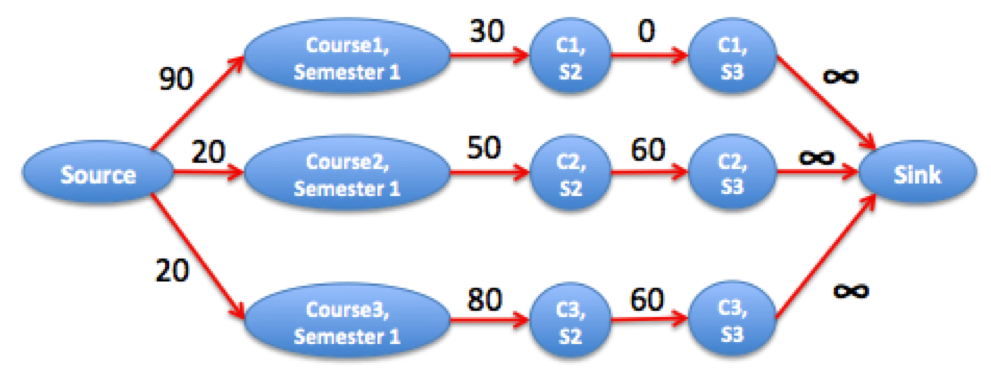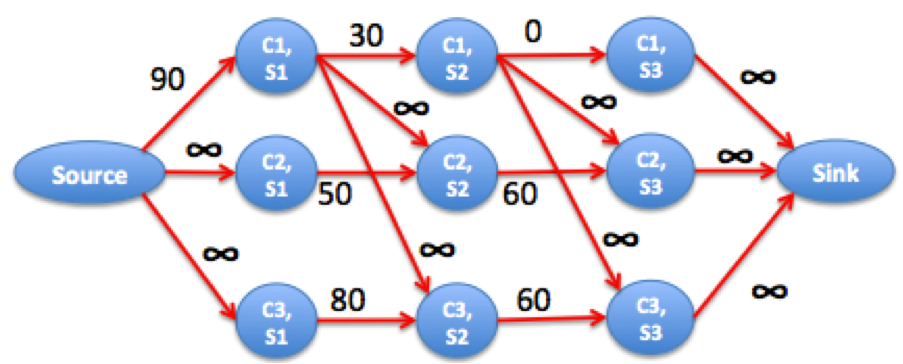Can anybody explain the network flow solution for the problem. It seems that answer for most of the users is the subtraction of maxflow value from some constant. How can this be the maximal score she can get ? ? .
Please explain your problem clearly
This is a beautiful problem, quite hard too. I tried hard to solve the problem during the contest and thought this could be solvable by network flow because it was easy to model it as an Integer Programming problem, but didn’t manage to get the right insights.
First, let’s ignore the dependencies. The answer is just the maximum grade per course in any of the semesters, which is trivial to compute but let’s put this in another perspective:
For each course, the best grade is 100 - (minimum grade we lose by picking one of the semesters).
To model this as a network flow graph, we do 4 things:
- Create a vertex for each pair (course i, semester j).
- Create a source vertex which is connected to the first semester of each course i by an edge with capacity 100 - grade(i, 1).
- For every semester j from 2 to M, connect the vertices of each course i from semester j-1 to j with capacity 100 - grade(i, j) or 100 if the course is not available (it’s the same as having grade 0, recall that it’s guaranteed there is a solution).
- Create a sink vertex and connect the last semester of each course to it, with infinite capacity.
Consider the following example with 3 courses and 3 semesters:
3 3
10 70 100
80 50 40
80 20 40

The corresponding graph is depicted in the above picture. The maximum flow is equal to the combined grade loss for all courses. We pick semester 3 for course 1 (zero loss), and semester 1 for courses 2 and 3 (loss 20+20).
The maximum grade average we can get is (N * 100 - maxflow) / N. In this case: (3*100 - 40) / 3 ~= 86.67.
- Returning to the problem, why does this help?
If we model the problem this way, we can also include the course dependencies. Suppose there are dependencies 1->2 and 1->3. The best we can do is course 1 in semester 2 and courses 2 and 3 in semester 3 for (70+40+40)/3 average.
- If there are dependencies 1->2 and 1->3, then courses 2 and 3 can never be done in the first semester.
This implies that the minimum grade loss for courses 2 and 3 is not bounded by its grades in semester 1. This is the same as changing the capacities associated to semester 1 of courses 2 and 3 to infinity.
- Why do we pick semester j for course 1?
The combined grade loss of doing course 1 in semester 2 + courses 2 and 3 in semester 3 is less than doing course 1 in semester 1 + courses 2 and 3 in semesters 2 or 3.
In terms of network flow, this means that
- if we pick semester j = 1, then courses 2 and 3 are not bounded by grade loss in semester 1. To combine the grade loss by picking semester 1, we connect vertex (course 1, semester 1) to (course 2, semester 2) and (course 3, semester 2) with infinite capacity.
- if we pick semester j = 2, then courses 2 and 3 are not bounded by grade loss in semesters 1 and 2. Same as above but connecting (course 1, semester 2) to courses 2 and 3, semester 3.
- picking semester j = 3 is not possible.
The resulting network is the following

We can see that the maximum flow is 150. The best is to distribute the grade loss of course 1 in semester 2, flow 3, among courses 2 and 3 in semester 3. In fact, 70+40+40 = 300 - 150.
To give you another example, consider the input
3 3 2
10 50 100
80 90 40
80 40 70
1 2
1 3
The best we can do course 1 at semester 1 (10) + course 2 at semester 2 (90) and course 3 at semester 3 (70) = 10+90+70. The resulting graph is

We can see that the maximum flow is 130 because in this case, it is better to distribute the grade loss of course 1 at semester 1, the flow 90, among the grade loss of courses 2 and 3 over semesters 2 and 3, respectively.
In a nutshell, we create a graph with N*M+2 vertices and use a standard maximum flow algorithm. The hard part was to realize how to build the network correctly.
Awesome explanation! This should definitely be the official editorial (or at least mentioned in the official editorial). The hardest part I believe is to justify to oneself that this works. The proof of correctness isn’t too easy, but intuitively this makes sense.
okie got it
Please can anybody tell why the editorial of only RIN is not available . Rest of editorials of DEC14 problems are up !
Thanks! Maybe there are theorems to prove this, but I don’t know.
The proof isn’t actually too bad. The way to look at it is as a min cut problem. There are 2 things you need to show. First, is that each course’s path will be cut exactly once. Second is that adding those edges with infinite capacities prevents us from cutting a course’s edge before its prerequisites. Both can be shown with some casework (i.e. if it was not true, we can either make the min cut smaller, or we can find a path from the source to the sink), which will show that mincut will correctly compute the right answer.